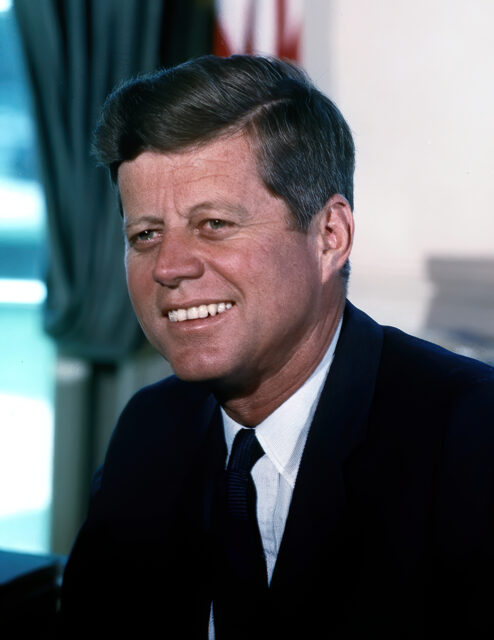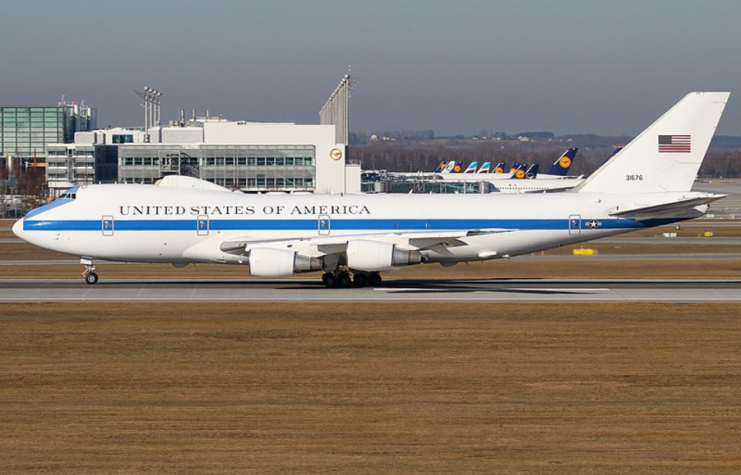During the 1960s, America’s Continuity of Operations plans included the National Emergency Command Post Afloat (NECPA). It was one of three parts – airborne, ground and sea-based – that would ensure the continued running of the government during the event of nuclear war. To make these plans a reality, the US Navy converted two ships into mobile command posts, often referred to as “Doomsday Ships,” which could have been used as floating White Houses in times of crisis.
Continuity of Operations

With the advent of nuclear weapons at the end of World War II, the US government began developing plans for the continuity of operations and survival of key figures during a nuclear war. It was decided there would be three parts to this. One was key installations on land, and the other two were mobile airborne and sea-based command posts, allowing the government to move at will.
Communications were a key part of the plan. A system was established so secure communications would be maintained between four command posts: the National Military Command Center (NMCC), the Alternate National Military Command Center (ANMCC), the National Emergency Airborne Command Post (NEACP), and the National Emergency Command Post Afloat (NECPA).
The National Military and Alternate National Military Command Centers were land installations – the Pentagon and a US military bunker near Blue Ridge Summit, Pennsylvania. The National Emergency Airborne Command Post would be aircraft operated by the US Air Force, while the National Emergency Command Post Afloat were command ships manned by the US Navy.
The two vessels would be on constant alert and ready to assume the role of floating White Houses, if needed. They ultimately never had to take on these roles, and only saw John F. Kennedy and Lyndon B. Johnson visit for exercises, overnight stays and as part of foreign trips.
USS Northampton (CLC-1/CC-1)

The USS Northampton (CLC-1/CC-1) was launched on January 27, 1951. She was an Oregon City-class heavy cruiser, but had very little resemblance to the other ships in her class. She was heavier, with a displacement of 13,700 long tons, while the rest had displacements of 13,260 long tons. The vessel was also faster, with a top speed of 38 MPH, with the others reaching 37.3 MPH.
Northampton boasted a different armament than the rest of her class. Initially, Oregon City cruisers has nine 8-inch guns in three turrets, twelve 5-inch guns in six turrets and various anti-aircraft guns. After 1953, these were changed. The 8- and 5-inch guns remained the same, and ten 3-inch guns in five turrets were added.
Northampton, however, was designed under project SCB 13 and made into a command cruiser on January 27, 1951, drastically changing the vessel from others in her class. For instance, Northampton had four 5-inch guns and eight 3-inch guns, which were later removed. She also had a considerable amount of antennas and other communications equipment, accompanied by large masts.
Less noticeable, while still significant, the ship had a larger crew. It took 2,000 sailors to control, while just 1,142 were needed for a typical Oregon City cruiser. In this role, she entertained many government officials and dignitaries, including King Baudouin of Belgium and King Olav V of Norway.
Northampton served in this role until 1961. On April 15, she was redesignated CC-1, with the purpose of acting as a floating White House as part of the National Emergency Command Post Afloat. Nicknamed “Sea Ruler,” she served in this capacity until April 8, 1970, when she was decommissioned.
USS Wright (CVL-49/AVT-7/CC-2)

The USS Wright (CVL-49/AVT-7/CC-2) was a Saipan-class light aircraft carrier commissioned into the US Navy on February 9, 1947. Initially, she acted as a qualification carrier for training pilots. In this role, the vessel took part in 40 operational cruises, all only lasting a few days at a time.
On January 11, 1951, Wright departed from Norfolk, Virginia to join the US 6th Fleet in the Mediterranean. She reached Gibraltar on January 21 and began her first deployment. In 1952, following an overhaul, she acted as the flagship for Carrier Division 14 and competed in exercises with NATO members, most notably the British Royal Navy.
Following another overhaul in 1953, Wright departed from the Philadelphia Naval Shipyard and joined the US 7th Fleet in the Pacific. After passing through the Panama Canal, with stops at San Diego and Pearl Harbor, Wright reached US Fleet Activities Yokosuka, Japan. With Marine Attack Squadron 211 onboard, the vessel operated off the coasts of Korea and Okinawa.
This cruise lasted until October 15, 1954, when Wright departed Japanese water for the West Coast of the US. She then began to prepare for inactivation, and was decommissioned and assigned to the Pacific Reserve Fleet.
Serving with the National Emergency Command Post Afloat (NECPA)

On March 15, 1962, Wright was converted into a command ship and redesignated CC-2. This only lasted a year, but saw extreme alterations to the ship in both function and appearance. Hangar bays were turned into command spaces, including elegant spaces for the president, and, most notably, the top deck, once used for aircraft to take off and land, saw various antennas installed atop large masts. Despite these changes, Wright could still operate helicopters at the rear.
Wright was recommissioned on May 11, 1963, and began operating off the West Coast, later moving to Norfolk. While part of the National Emergency Command Post Afloat, the vessel, nicknamed “Zenith,” became “the most sophisticated communications platform ever placed at sea.”
The aircraft carrier’s most noteworthy operations actually had nothing to do with her role. Between April 11-14, 1967, Wright operated off the coast of Uruguay, providing communications for President Lyndon B. Johnson during a conference at Punta del Este. As well, on May 8, 1968, she towed the USS Guadalcanal (LPH-7) 84 miles back to port after she’d suffered mechanical issues and became dead in the water.
In February 1969, during the Pueblo Crisis, Wright was put on high alert at Norfolk, although she never had to be used. The vessel was decommissioned on May 27, 1971.
National Emergency Airborne Command Post (NEACP)

In the early-to-mid-1960s, the US government considered converting the USS Triton (SSRN-586) or a second Saipan-class ship into a third National Emergency Command Post Afloat. However, it was deemed unnecessary and the conversion never took place, with only the two remaining in the role until decommissioning in the 1970s.
If it was necessary for the president or other American commanders to use a ship in such a role, that could be arranged, although it was considered unnecessary to have one designated only for that. This led to the creation of a National Emergency Airborne Command Post, which came in the form of the Boeing E-4.
Based on Boeing’s incredibly successful 747 airliner, four E-4s were produced, with the E-4A entering service in late 1974 and the E-4B in ’80. Earlier variants were updated, with all four becoming E-4Bs by 1985. With a crew of four, operation was no different than when operated by an airline.
That being said, the E-4’s systems aren’t anything like an airliner’s. With advanced satellite communications systems, protection against electromagnetic pulses, and nuclear and thermal effects shielding, it’s a highly advanced and effective mobile command post.
More from us: Messerschmitt Me 410 Hornisse: The German Bomber Destroyer That Was No Match for Allied Fighters
The US Air Force still operates the E-4, and while the service began developing a replacement in 2021 and ’22, it has yet to retire from duty. In addition to the E-4, two Boeing VC-25 – or Air Force Ones – are also equipped with similar systems and can act in such a role when called upon.
